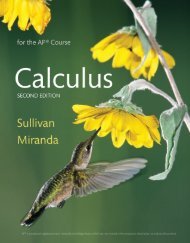Sullivan Microsite TE SAMPLE
You also want an ePaper? Increase the reach of your titles
YUMPU automatically turns print PDFs into web optimized ePapers that Google loves.
<strong>Sullivan</strong> AP˙<strong>Sullivan</strong>˙Chapter01 October 8, 2016 17:4<br />
<strong>Sullivan</strong><br />
106 Chapter 1 • Limits and Continuity<br />
AP® CaLC skill builder<br />
for example 5<br />
Determining Whether a Function Is<br />
Continuous on a Closed Interval<br />
⎧<br />
⎪<br />
fx ( ) = ⎨<br />
⎪<br />
⎩<br />
2<br />
x −3x−4<br />
x − 4<br />
k<br />
x ≠ 4<br />
x = 4<br />
Determine the value of k that makes the<br />
function f defined above continuous at<br />
x = 4.<br />
Solution<br />
The function will be continuous at x = 4 if<br />
lim fx ( ) = lim fx ( ) = f (4).<br />
− +<br />
x→4 x→4<br />
In Example 4, we showed that the floor function f (x) =x is discontinuous at<br />
x = 1. But since<br />
f (1) =1 =1 and lim f (x) =x =1<br />
x→1 +<br />
the floor function is continuous from the right at 1. In fact, the floor function is<br />
discontinuous at each integer n, but it is continuous from the right at every integer n.<br />
(Do you see why?)<br />
2 Determine Intervals on Which a Function Is Continuous<br />
So far, we have considered only continuity at a number c. Now, we use one-sided<br />
continuity to define continuity on an interval.<br />
DEFINITION Continuity on an Interval<br />
• A function f is continuous on an open interval (a, b) if f is continuous at every<br />
number in (a, b).<br />
• A function f is continuous on an interval [a, b) if f is continuous on the open<br />
interval (a, b) and continuous from the right at the number a.<br />
• A function f is continuous on an interval (a, b] if f is continuous on the open<br />
interval (a, b) and continuous from the left at the number b.<br />
• A function f is continuous on a closed interval [a, b] if f is continuous on the<br />
open interval (a, b), continuous from the right at a, and continuous from the left<br />
at b.<br />
Figure 26 gives examples of graphs over different types of intervals.<br />
x<br />
lim fx ( ) = lim<br />
−<br />
−<br />
x→4 x→4<br />
−3x−4<br />
x −4<br />
( x+ 1)( x−4)<br />
= lim<br />
−<br />
x→4<br />
( x −4)<br />
= lim ( x + 1)<br />
−<br />
x→4<br />
2<br />
y<br />
f(a)<br />
y f (x)<br />
a<br />
b x<br />
lim f(x) f (a)<br />
x→a <br />
(a) f is continuous on [a, b).<br />
y<br />
f(a)<br />
y f (x)<br />
a<br />
b x<br />
lim f(x) f (a)<br />
x→a <br />
(b) f is continuous on (a, b).<br />
y<br />
f(b)<br />
y f (x)<br />
a<br />
b x<br />
lim f(x) f (b)<br />
x→b <br />
(c) f is continuous on (a, b].<br />
y<br />
y f (x)<br />
f(b)<br />
a<br />
b x<br />
lim f(x) f (b)<br />
x→b <br />
(d) f is continuous on (a, b).<br />
y<br />
f(b)<br />
y f (x)<br />
f(a)<br />
a<br />
b x<br />
lim f (x) f (a)<br />
x→a <br />
lim f (x) f (b)<br />
x→b <br />
(e) f is continuous on [a, b].<br />
= 5<br />
Figure 26<br />
x<br />
lim fx ( ) = lim<br />
+ +<br />
x→4 x→4<br />
−3x−4<br />
x −4<br />
( x+ 1)( x−4)<br />
= lim<br />
+<br />
x→4<br />
( x −4)<br />
= lim ( x + 1)<br />
+<br />
x→4<br />
= 5<br />
If we define f (4) = 5, the function f will be<br />
continuous at x = 4.<br />
2<br />
For example, the graph of the floor function f (x) =x in Figure 25 illustrates<br />
that f is continuous on every interval [n, n + 1), n an integer. In each interval, f is<br />
continuous from the right at the left endpoint n and is continuous at every number in the<br />
open interval (n, n + 1).<br />
EXAMPLE 5<br />
Determining Whether a Function Is Continuous<br />
on a Closed Interval<br />
Is the function f (x) = √ 4 − x 2 continuous on the closed interval [−2, 2]?<br />
Solution The domain of f is {x|−2 ≤ x ≤ 2}. So, f is defined for every number in<br />
the closed interval [−2, 2].<br />
For any number c in the open interval (−2, 2),<br />
lim<br />
x→c<br />
f (x) = lim<br />
x→c<br />
So, f is continuous on the open interval (−2, 2).<br />
√<br />
4 − x<br />
2<br />
= √ lim<br />
x→c<br />
(4 − x 2 ) = √ 4 − c 2 = f (c)<br />
AP® Exam Tip<br />
The topic of continuity on an interval<br />
is generally not directly tested on the<br />
exam. The concept, however, is still<br />
important because many important<br />
theorems that do appear on the exam<br />
are applicable only for functions that<br />
are continuous on a closed interval.<br />
106<br />
Chapter 1 • Limits and Continuity<br />
<strong>TE</strong>_<strong>Sullivan</strong>_Chapter01_PART I.indd 3<br />
11/01/17 9:58 am




